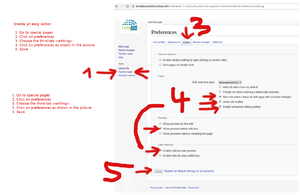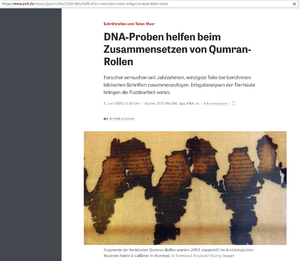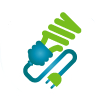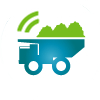WS1
The first workshop of EERAdata is organized as an online webinar and hackathon from June, 2-4, 2020.
Contents
Objective
- Learn about FAIR and open data practices in the energy and other research communities;
- Choose selected databases to be investigated in use cases. Discuss and summarize the reasons for selection.
- Analyze the state of FAIR/O principles for the selected database (with the help of the questionnaire and FAIR/O assessment tools).
- Evaluate the state of FAIR/O principles for the metadata of selected databases.
- Suggest general principles for the design of metadata (use-case- and domain-specific),
- Discuss top-level metadata adhering to FAIR/O principles (use-case- and domain-specific),
- Learn about the FAIRification of Data Management Plans (DMP).
Read aheads
Obligatory:
- M. D. Wilkinson et al., “The FAIR Guiding Principles for scientific data management and stewardship,” Scientific Data, vol. 3, p. 160018, Mar. 2016. https://doi.org/10.1038/sdata.2016.18
- B. Mons et al., “Cloudy, increasingly FAIR; revisiting the FAIR Data guiding principles for the European Open Science Cloud,” Information Services & Use, vol. 37, no. 1, pp. 49–56, Jan. 2017. https://doi.org/10.3233/ISU-170824
- EOSC HLEG (2018). Final report and recommendations of the Commission 2nd High Level Expert Group on the European Open Science Cloud (EOSC). Prompting an EOSC in practice. Available online: https://publications.europa.eu/en/publication-detail/-/publication/5253a1af-ee10-11e8-b690-01aa75ed71a1 (accessed: 18.07.2019).
Suggested read on the history of metadata: Metadata - Shaping Knowledge from Antiquity to the Semantic Web by Richard Gartner, https://www.springer.com/gp/book/9783319408910
Join and collaborate interactively!
The workshop is a hackathon! EERAdata is evolving jointly only! Join the discussions and work together online:
- EERAdata WIKI
- EERAdata storyboard
- EERAdata@github
- EERAdata@ResearchGate
- Post your questions and comments on slido: https://app.sli.do/event/wrz7iwdh - OR go to slido.com and enter the event code: 23069
EERAdata story board
Objective: collect views from participants regarding energy data, energy metadata, FAIR/O problems etc. to support discussions, identification of gaps & needs (WP2) and elements to design the platform (WP3).
Questions:
- Q#1: What is your user story regarding FAIR/O energy data?
- Q#2: What is your user story regarding metadata?
Template to answer: As a <stakeholder>, I want <goal> so that <reason>.
How to post a story?
- Click on the link: https://padlet.com/janaschwanitz/aciywzt9fs1h70m2
- Click on plus at the right bottom to add a story.
- Choose as title depending on the question one wants to answer. Choose for Q#1: FAIR/O data, or for Q#2: metadata. In the example above, the title “metadata” was chosen.
- Type your sentence to let us know where the gaps and hopes are: The template is: As a <stakeholder>, I want <goal> so that <reason>.
Example: As a data-driven energy researcher, I want utopia - i.e. one-stop access to all relevant metadata -, so that I can browse available data, check where they are from and whether I can trust them when reusing.
How to comment a story?
- One can rate stories by clicking on a number of stars.
- One can comment stories as well as comments with words.
- It is anonymous commenting and adding of stories, as long as one does not login into one's personal profile at padlet.com.
EERAdata wiki - How to?
The easiest way is you simply start writing and editing. You can install an easy editor by doing what is described in the picture to the right.
Consult the User's Guide for information on using the wiki software.
- Configuration settings list
- MediaWiki FAQ
- MediaWiki release mailing list
- Localise MediaWiki for your language
- Learn how to combat spam on your wiki
EERAdata on github
Link here and share your thoughts and issues! Note, work in progress.
EERAdata @ Research Gate
Link here and share your thoughts and issues! Note, work in progress.
Just have fun!
Metadata memory game
Read before playing: This is a little memory game where players need to identify triples, that is three tiles that belong to one data set. All of them relate to low carbon energy. Some tiles have the form of a picture, others show metadata descriptions (in various formats) and some are even sound files. So, the game is to have fun, while learning about metadata. Try out if you can find all triples. Note if you have opened 3 tiles and they do not match, all will automatically close. Just as you know it from a real-life memory game. Link
Agenda and notes Day 1
Builds on read aheads. Online talks and discussions. Space for interaction with participants after each presentation. Moderated discussion of collected comments.
| Time slot | Topic |
|---|---|
| 10.00-10.20 | Welcome and introduction with workshop goals and procedures: “EERAdata - Towards Utopia for low carbon energy research”, Valeria Jana Schwanitz, HVL & PI EERAdata. Link: [1]. Main points:
|
| 10.20-12.15 | Online lectures:
“The EOSC Nordic: machine-actionable FAIR maturity evaluations & the FAIRification of data repositories” - Andreas Jaunsen, Nordforsk & EOSC-Nordic. Link: [2]. Main points:
“OpenAIRE: Open Access Infrastructure for Research in Europe”, Ilaria Fava, OpenAIRE. Link: [5]. Main points:
A short break of 15 min - “Community-driven metadata and ontologies for Materials Science and their key role in artificial-intelligence tools”, Luca Ghiringhelli, FHI Berlin. Link: [12]. Main points:
“Metadata practices from IRP Wind”, Anna Maria Sempreviva, DTU. Link: [14]. Main points:
|
| 12.15-13.00 | Lunch Break. Play the EERAdata game “Utopia and metadata”. Or any time. |
| 13.00-14.00 | Online lectures:
“Humanities and data: for a community-driven path towards FAIRness”, Elena Giglia, UNITO. Re-using presentation held at the Open Science Conference 2020 in Berlin. Presentation stored at zenodo. Link: [16]. Main points:
“RISIS - An e-Infrastructure for the STI-Policy research community”, Thomas Scherngell, AIT. Link: [17]. Main points:
|
| 14.00-14.30 | Break - Game “Utopia and metadata”. Or any time. |
| 14.30-16.00 | Discussion to compile a to-do list for work in use cases on the second day. Serves as a guiding and aligning process. Lead by WP2, August Wierling/Valeria, HVL. What is the take-to-day-2 message for your use cases?
|
Agenda Day 2
News of the day before
Not energy, but an inspiring connection: Perhaps unexpected, or perhaps even not: DNA helps to puzzle pieces of Qumran role. DNA taken from animal skins that were used to write on ...
FAIR data and FAIR METADATA - DISCUSSIONS in use cases, parallel sessions
Work in use cases on databases and metadata, led by use case leaders. Suggested outline:
- 10-12 Discuss and update the preliminary state of FAIR/O for the use case. Use the prepared draft of databases to check compliance with FAIR principles (tools: WP3 questionnaire and others). Compare the assessment results for each database. Observe and discuss agreements and differences across the evaluation tools. Generate the overall picture for FAIR/O compliance for the use case to pin down the state of art. Let’s see if we come to the same result as in our initial assessment for the application (traffic lights). Continuously make notes to report later on results. Select a responsible person. Objective: select 3-5 databases per use case. Discuss which databases to select. One to cover use-case specific challenges; and one with cross-use case relevance, and one a low hanging fruit for which it would be relatively easy to improve the current FAIR/O status.
- 13-15 Joint brainstorming to discuss FAIR/O state of the metadata for the selected use cases. Evaluate: What is the current description of metadata? How extensive are they? Is only administrative information provided? Or richer context description? What frameworks for metadata are used: taxonomy? thesaurus? ontology? How is the metadata information technically implemented: plain text file? xml? rdf? ... Identify use case specific issues with metadata - What are the gaps? What is perceived as a hard nut to crack? Pay special attention to the metadata of the databases and fill out the table provided WP2. Continuously make notes to report results the next day! Select a responsible person!
- from 15 Joint recordings of lessons learned. Create and/or update the WIKI for the use case with literature, gaps, best practices, FAIR/O discussion, metadata discussion, suggested next steps, .... Get your head around what to report next day! Plan for 20 min. See the links to WIKI page templates below (Notes from Day 2).
Issues identified across use cases
| Use case 1 | Use case 2 | Use case 3 | Use case 4 |
|---|---|---|---|
| Buildings efficiency | Power transmission & distribution networks | Material solutions for low carbon energy | Low carbon energy and energy efficiency policies |
| Gaps & challenges per use case in a nutshell | |||
|
|
|
|
|
Use case 1: Continuously updated summary page UC1, |
Use case 2: Continuously updated summary page UC2, |
Use case 3: Continuously updated summary page UC3, |
Use case 4: Continuously updated summary page UC4, |
Note: This schedule is a suggestion. Adjust and organize breaks as needed.
Special session - FAIR data evaluation by machine
15.30 - 16.00 Andreas Jaunsen, Nordforsk. Presentation of the results from an automated FAIR evaluation for selected repositories suggested by the use cases.
The proposed list of databases to check:
- EUR-Lex: https://eur-lex.europa.eu/homepage.html?locale=en
- JRC: https://data.jrc.ec.europa.eu/
- IEA: https://www.iea.org/policies/about
- Nomad database: https://www.nomad-coe.eu/index.php?page=nomad-repository
- OPSD: https://open-power-system-data.org/
- ENTSO-E Transparency Platform https://transparency.entsoe.eu/
- ExCEED - European Energy Efficient building district Database https://dashboard.exceedproject.eu/
- EU Building Stock Observatory: https://ec.europa.eu/energy/topics/energy-efficiency/energy-efficient-buildings/eu-bso_en
Results Note: 22 indicators with the FAIR Maturity Evaluation Service are tested. 0 stands for "failing the test", 1 stands for "standing the test".
Most of them are a mix of web-pages (of repositories). Thus, a random dataset from a few of them was selected.
| Database link | Result link | Result across 22 indicators | Aggregate result across FAIR categories |
|---|---|---|---|
| https://eur-lex.europa.eu/legal-content/EN/TXT/?uri=OJ:JOC_1999_093_R_0001_01 | https://fair.etais.ee/evaluation/4842 | 1001100001010110000000 | 37.50% 40.00% 28.57% 0.00% 31.82% |
| https://data.jrc.ec.europa.eu/dataset/93d07f10-7757-485f-bb8e-3160536b97f8 | https://fair.etais.ee/evaluation/4843 | 1001110011110110011100 | 0.00% 80.00% 71.43% 0.00% 59.09% |
| https://onlinelibrary.wiley.com/doi/abs/10.1002/aenm.201902830 | https://fair.etais.ee/evaluation/4844 | 1000000001010000000000 | 12.50% 40.00% 0.00% 0.00% 13.64% |
| https://doi.org/10.25832/conventional_power_plants/2018-12-20 | https://fair.etais.ee/evaluation/4845 | 1101110011110110011100 | 62.50% 80.00% 71.43% 0.00% 63.64% |
See also: https://www.rd-alliance.org/groups/fair-data-maturity-model-wg and https://fairsharing.github.io/FAIR-Evaluator-FrontEnd/#!/
Agenda and notes from Day 3
Reporting experience from use case applications. Prepare the next workshop on workflows and metadata. Introduction and discussion of data management plans.
| Time slot | Topic |
|---|---|
| 10-12.00 | Discussion lead by WP2. Report from use case experiences (by use case leaders). Wrap up.
|
| 12-12.30 | Presentation "Some pitfalls in data base licenses", Carsten Hoyer-Klick, DLR - German Aerospace Center. Main points:
|
| 12.30-13.30 | Lunch break |
| 13.30-15.00 | Data Management Plans
Presentation “Introduction to DMP and best practices” by Trond Kvamme, NSD. Link: [21] Main points:
Presentation on Machine-actionable DMPs by Tomasz Miksa, TU Vienna. Link: [27] Main points:
Discussion of EERAdata DMP draft (August, HVL). Main points:
|
| 15.15-16.00 | Wrap up of workshop with feedback from invited experts. |
Notes from Day 3
- Bulleted list item
WS1 through the lense of an artist
Day 1 presentations
- Selection 190.png
The EERAdata workshop seen by artist Barbara Bellier
- Selection 191.png
The EERAdata workshop seen by artist Barbara Bellier
- Selection 192.png
The EERAdata workshop seen by artist Barbara Bellier
- Selection 193.png
The EERAdata workshop seen by artist Barbara Bellier








